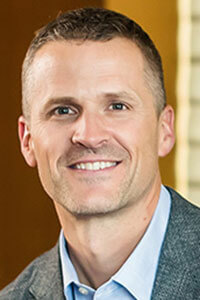
The Sioux Falls skyline rises behind the waterfalls in Falls Park. The South Dakota city’s mayor created an innovation team to tackle transit issues after attending a leadership summit. (Courtesy Sioux Falls Convention & Visitors Bureau)
Sioux Falls Mayor Paul TenHaken was inspired to tackle his city’s inefficient transit system after attending a three-day, immersive classroom experience summit that kicked off the 2018 class of the Bloomberg Harvard City Leadership Initiative, according to several reports.

Mayor Paul TenHaken
The annual initiative — a collaboration between Bloomberg Philanthropies, Harvard Kennedy School, and Harvard Business School — is a yearlong professional development program for 40-plus mayors from around the globe. Each class meets with Harvard faculty and management experts for a three-day workshop that gets the program underway. TenHaken said that he was struck by hearing other mayors talk about their innovation teams and chief innovation officers, according to a Bloomberg Cities article, which is not something Sioux Falls had in place.
So after the workshop, TenHaken — a tech executive who promised in his mayoral election campaign to apply the tools of tech innovation to city government — assembled a department of innovation and technology to address the broken transit system. What was notable about the core team of city workers he picked was that only one had previous transit experience. The diverse team, according to an AARP article, included a firefighter, police officer, librarian, and health-care worker.
“No one has a monopoly on good ideas,” TenHaken said in the Bloomberg Cities post. “Sometimes when you get people out of their lane, they’re more apt to come up with new ideas and strategies that never would have bubbled up before.”
Team members rode buses and met with riders, business leaders, university officials, and others to research what was working and what needed to be fixed. And they used a workshop “ideation” process to churn out ideas: Joined by several Sioux Falls residents, they worked in small groups around tables covered in butcher paper they could scribble and draw on and collectively came up with 50 ideas for improving transportation service. Participants voted on which ideas they liked best by placing stickers next to their favorites.
Late last year, the core group presented their recommendations: Eliminate all dedicated bus routes and enable riders to use a smartphone app, computer, or landline to call for a ride. The pilot program will work “not unlike a ride-sharing service,” AARP reports, and if successful, part of the bus fleet will be replaced with vans and cars.
“We’re experimenting and we’re innovating on a very public stage,” TenHaken told AARP. “The alternative is to do nothing at all.”
Michelle Russell is editor in chief of Convene.
